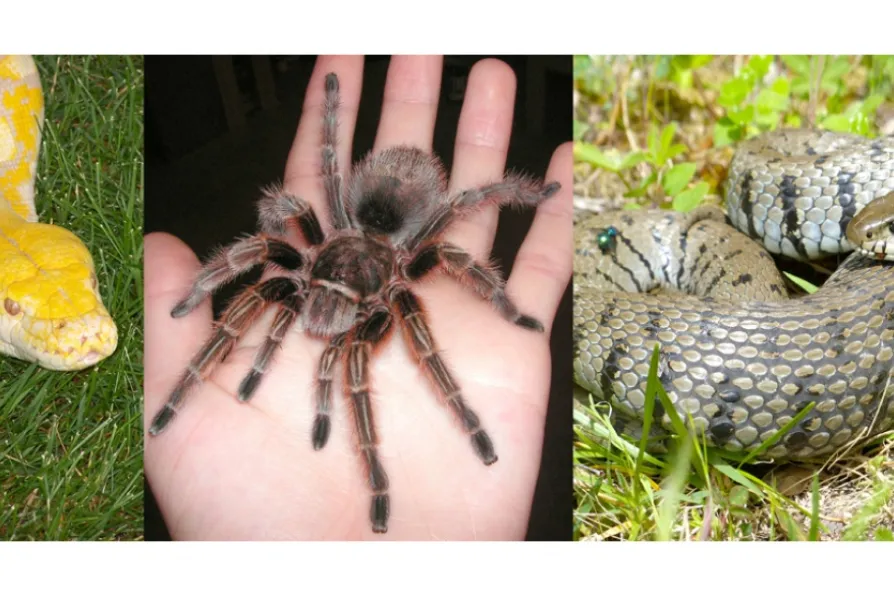Durham Miners’ Association general secretary ALAN MARDGHUM speaks to Ben Chacko ahead of Gala Day 2025

 ENCOUNTERS OF A NEW KIND: (Right to left) An albino Burmese python, Chilean Rose Hair Tarantula and a barred grass snake, which is native to our country
[SEWilco/Psychonaught/Bernard Dupont/Creative Commons]
ENCOUNTERS OF A NEW KIND: (Right to left) An albino Burmese python, Chilean Rose Hair Tarantula and a barred grass snake, which is native to our country
[SEWilco/Psychonaught/Bernard Dupont/Creative Commons] LAST year along the canal towpath in rural Northamptonshire we started to hear tales of sightings of a large, exotic and colourful snake, or maybe, more than one.
The similar descriptions from the few people who had had a decent sighting suggested it might be the albino Burmese python — a beautiful golden-blond snake — favoured both by pet-keepers as well as by exotic or even erotic dancers.
It is all too easy to buy a pet python on the internet or from a specialist dealer. You don’t need a special licence. Snakes are being caught in the wild and then illegally imported using forged papers suggesting they were bred in captivity. A six-foot python might cost between £50 and £250 from an internet dealer.
Sadly these extremely popular pet pythons grow quickly and are often released or escape when they grow too large for their tanks.
In the wild they can grow up to 19 feet long. They eat small mammals and birds and would have no problem living beside the canal or at other locations in our countryside.
The RSPCA says it is receiving more snake calls than ever before. Between January and midsummer over 200 exotic animals had been reported — including pythons, other snakes, lizards and even tarantulas.
Snakes escape from their homes all year round, but if they do so in winter they find somewhere dark and hibernate there until the weather improves.
There are fears reptile owners are dumping snakes in the wild because they cannot look after them. The more you feed your snake the bigger it grows.
Scary tales of giant escaped snakes frequently appear in the media.
Dan Brandon — an experienced snake handler — was found strangled at his home in Hampshire last summer. One of his many snakes, a pet python, was out of its pen and lying near the body.
The experienced snake enthusiast died of asphyxiation. The coroner had to decide whether the python played any role in its owner’s death. This was the first time a python has ever been linked to a death in Britain.
It is quite rare for pythons to attack humans. In the US, where snake keeping is far more common, more than 20 people have died in constrictor snake-related incidents in the last decade.
In 2013, two Canadian brothers aged four and six years old were killed after an African rock python escaped from its cage in a pet shop near their bedroom
Other British press stories include that of a boa constrictor as thick as a man’s thigh and over eight feet long that turned up at Wiltshire Wildlife Hospital near Salisbury. It was dumped at the entrance during the early hours of the morning. Wildlife care supervisor Marilyn Korkis said: “It took two people to lift it. It was huge — the thickness of a man’s thigh.”
Soldiers training in Farnborough, Hants, found a 6ft-long anaconda. The soldiers captured the yellow-coloured snake and brought it to an RSPCA centre in Brighton where it was cared for while an appeal went out to trace the owner.
Peter Yarde, on behalf of the RSPCA, told the Morning Star: “Exotic pets often end up in our care after people realise they’re not easy to care for or once the novelty wears off. Hundreds are reported every year.
“Some are rescued after they’ve escaped, some have been released on purpose. Some species can be difficult for us to re-home, due to a lack of suitable homes or interest.
“Non-native species may not survive in our countryside and are illegal to release, as they could be an invasive species posing a risk to our native wildlife.”
Exotic reptiles and amphibians began surging in popularity as pets in the early 1990s in Europe, the US and Japan. From 2004 to 2014, the EU imported nearly 21 million. In the US an estimated 4.7 million households owned at least one reptile in 2016.
Plucking animals from the wild is cheaper and easier than setting up a breeding operation. Generally, villagers capture animals in forests and fields, and sell them to middlemen who pass them on to legal reptile farms.
The owners of the farms acquire forged or original government paperwork certifying that the animals were captive-bred.
As long as I have been studying and writing about British reptiles I have understood that Britain is home to three kinds of wild snake.
The grass snake, the very rare smooth snake and the only British venomous snake the adder or viper.
We also have a legless lizard, the slow worm which is often confusingly identified as a snake.
Now it seems there are four native snakes and have always been four. The newly identified species is the barred grass snake, Natrix helvetica. It is now recognised as a species in its own right distinct from the common or eastern grass snake (Natrix natrix).
I have often written about grass snakes, which grow to more than one metre (3ft) in length, live near water and mainly feed on amphibians such as frogs, toads and newts. One neighbour of mine has a five foot long example living wild in her large garden.
The newly identified barred grass snake is more greyish in colour than its olive green cousin and lacks its most striking feature, a bright yellow collar. Dark bands along the body are much more pronounced than in their common cousin.
The most numerous snake in Britain is the adder — the only native venomous snake. Bite symptoms include immediate and intense pain, followed by swelling and tingling. The last person in Britain to die from a wild snake bite was in 1975.
Adders are relatively common in areas of rough, open countryside and are often associated with woodland edge habitat, however, they are very choosy about their locations and the breed is under serious threat of extinction. They can grow up to 3ft and live for 15 years.
Despite the fact that in Britain, it is illegal to kill, injure, harm, or sell them many adders and indeed other snakes are killed deliberately.
Please don’t join in the slaughter. If you see an adder keep clear and let it live in peace. If you see a more exotic snake report it to the RSPCA or your local wildlife trust.
Frosty’s Ramblings appears every Friday in the Morning Star.



















